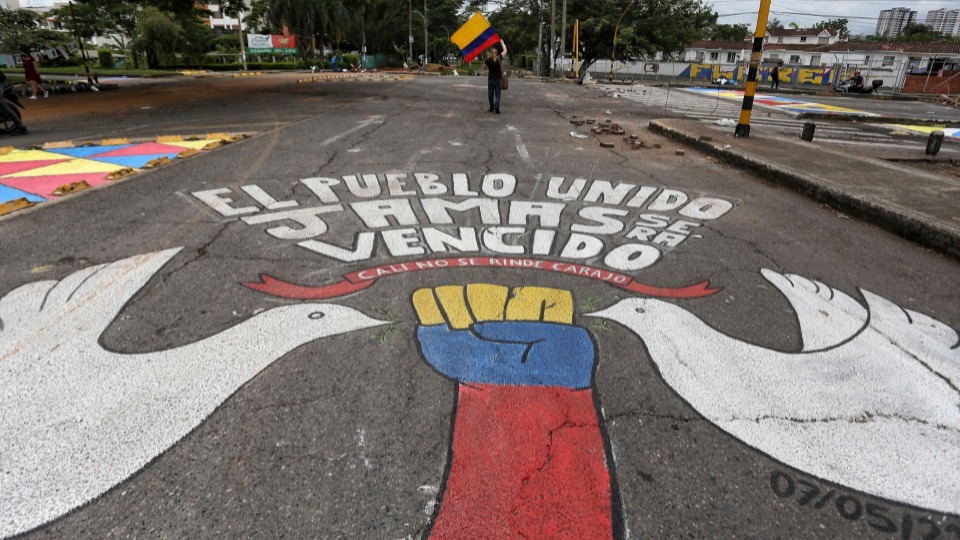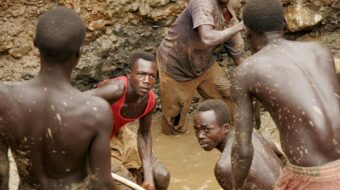
Colombia is afire with a National Strike mounted by working people, young people, and the excluded. They are protesting neoliberal reforms that diminish lives and hopes. Tax reform proposals from President Iván Duque’s right-wing government triggered large demonstrations that began on April 28 and are continuing. Although the government quickly withdrew the tax proposals and the finance minister was dismissed, brutal repression has inflamed the rebellion.
A National Strike Committee coordinates the actions of “26 social sectors at the national level” plus regional, departmental, and municipal strike committees. The demonstrations, unprecedented in size and scope, follow the student uprising of 2011, the agrarian strike of 2013, marches in September 2020 against police abuses, and a large strike in November 2020 against pension and education reforms.

One stimulus for the uprising is the rise in poverty in Colombia from 37.5% of the population in 2019 to almost 50% in 2020; 15% live in extreme poverty. Another is widespread disapproval of the government’s handling of the COVID-19 pandemic. Young people are enraged. Their futures are blunted, claims commentator Germán Muñoz González. Often regarded as “expendable,” they are being killed, he asserts. Polling shows that 75% of Colombians support the National Strike.
Colombian Cecelia Zamudio paints a grim picture. Protesters “are constantly being attacked by the forces of state repression who shoot with high caliber rifles…use weapons of war” and “utilize paramilitaries for covert actions.” So far, she reports that more than 60 people have been killed, 600 people taken away and disappeared, and thousands injured and imprisoned.
The proposed tax reforms represented the tip of the neoliberal iceberg. Health care privatization after 1993 led to health inequalities because of reduced investment in personnel, training, and facilities. Over the course of three decades, most education at all levels has been privatized. For the “poorest sectors of the population, public education for children and adolescents has deteriorated.”
Flexible labor arrangements developing over three decades have centered on outsourcing. Self-employment, mostly work in the informal sector, now exceeds 60%; the unemployment rate is 18%. In the same neoliberal spirit, the government farmed out management of pension and disability funds to banks. Consequently, the equivalent of $83 billion of workers’ and employers’ money held by bankers is profitably invested and pension benefits are reduced.
The proposed tax reform program was supposed to have supplied the government with the equivalent of $6.3 billion that would have enabled payment on debt that between 2016 and 2021 jumped from $79 billion to $157 billion, a figure representing 58% of Colombia’s GDP. Payment to foreign creditors consumes 38% of the government’s budgeted expenses.
The tax plan called for assessing a value-added tax (VAT) on rent payments by those earning the equivalent of $470 per month or more. Some previously exempt renters would have now been paying the tax. The plan also required that middle-income private and public sector workers pay a 19% VAT on fees for energy use, water, and sewerage. People with big inheritances would have seen higher taxes. Well-to-do Colombians opposed the tax proposals along with lower-income people, but for sometimes different reasons.
The National Strike Committee met May 15 with the government’s minister of labor and the high commissioner for peace. The Committee announced that no further negotiations would take place without guarantees assuring “no more violence and freedom to protest.” President Duque quickly responded: “In Colombia, full guarantees exist for the exercise of protests.” He declared that blocking highways represented criminal action “affecting the economy.”
The National Strike Committee indicated that future negotiations must involve the departmental and municipal strike committees. As with earlier national strikes, people’s assemblies are underway—in Ibagué, for example.
The Colombian state looks to be on the verge of ungovernability. Taken together, longtime negative features of Colombia’s national existence now pose formidable obstacles. They are: divisions between rich and poor, urban and rural; state power in the hands of oligarchs; continuing destitution and precarious lives for the many; their exclusion from meaningful political participation; ruling class willingness to resort to extreme violence; and governmental complicity with U.S. hegemonic ambitions. Integration of the national economy into the worldwide neoliberal system, with its own set of stern requirements, is relatively new.
The government has failed a three-part stress test.
- Colombians have suffered more from the COVID-19 pandemic than all but a few peoples of the world.
- The state’s implementation of the peace agreement between the FARC insurgents and the government was disastrous.
- There is the debt crisis.
Piedad Córdoba, once a left-leaning Liberal Party senator and always a target of reactionaries, portrays the strike as “only the most prominent symptom of a social order that’s now unsustainable.” She calls for the “development of social struggle” and laments that “in contrast to other countries of Our America, Colombia has not had a revolution of any type.”

She regards the high levels of poverty and debt as “big changes obliging us to look for [new] solutions.” Córdoba rejects neoliberalism and anticipates “a movement of new and developing leaders, and of generational change on the part of young people condemned to no future.”
Observer Fernando Rubio agrees: “The main protagonists of the present strike are young people impacted by the breakdown of the neoliberal model.” These include “professionally trained people facing bankruptcy, the chronically unemployed, and those living precariously without a future.”
Hope is alive for some Colombian young people. That’s apparent in the faces of the 200 or so orchestra members performing in Medellín’s Park of Desires on May 5. Under the baton of Susana Boreal, 26 years old, and before 6,000 singing onlookers, they played and sang “El pueblo unido jamás será vencido” (The people united will never be defeated), and other numbers.
The symbolism is clear. That song materialized in Chile prior to the overthrow of President Salvador Allende’s socialist government. It’s since been heard worldwide. The title, morphed into a slogan, became a staple of political demonstrations throughout the Western Hemisphere. Readers may go here or here to hear and see the performance.
The youth uprising in Colombia parallels the massive outpourings of young Chilean protesters from October 2019 onward, the Occupy phenomenon in the United States in 2011, and the Indignados in Spain. Maybe, one might surmise, a new way of doing politics is afoot.
Colombian youth in rebellion, acting spontaneously and mostly unaffiliated with political parties, are perhaps attending to moral and community values as they defend their material interests. They are workers—or would-be workers—but presumably don’t carry the sectarianism and memories of failure burdening their left-leaning predecessors.












Comments